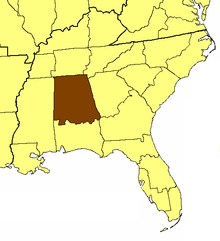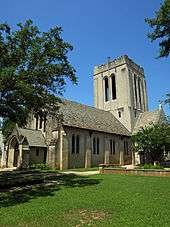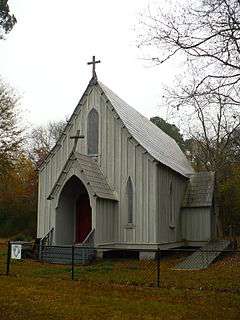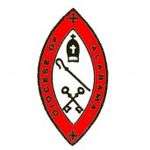Episcopal Diocese of Alabama
| Diocese of Alabama | |
|---|---|
|
Diocesan Seal of the Diocese of Alabama | |
| Location | |
| Territory | Northern and central Alabama |
| Ecclesiastical province | Province IV |
| Information | |
| Denomination | Episcopal Church |
| Cathedral | Cathedral Church of the Advent |
| Current leadership | |
| Bishop | The Right Reverend John McKee Sloan, Diocesan Bishop |
| Map | |
 | |
| Website | |
The Episcopal Diocese of Alabama[1] is located in Province IV of the Episcopal Church and serves the state of Alabama with the exception of the extreme southern region, including Mobile, which forms part of the Diocese of the Central Gulf Coast.
Currently, the Right Reverend John McKee "Kee" Sloan serves as diocesan bishop with Santosh Marray serving as assistant bishop. Sloan was elected by the diocese to serve as its 11th bishop on July 16, 2011, and was installed into that office on January 7, 2012, having previously served from 2008 to 2012 as bishop suffragan.[2] The Cathedral Church of the Advent in Birmingham serves as its cathedral. The Bishops' Offices are located at Carpenter House in Birmingham alongside the Church of the Advent, a pre-existing parish that the diocese designated as its cathedral in 1982.
The diocese currently includes 92 parishes, including college campus ministries and Camp McDowell, the diocesan camp and conference center, located in Nauvoo, Alabama.
The total membership of the diocese is estimated at over 30,000 persons. Alabama is the only diocese in the Episcopal Church where there are no mission congregations; that is, all churches are expected to be self-supporting and self-governing parishes, with diocesan subsidies reserved for new church starts only. The policy was instituted by Bishop Furman C. Stough in the 1970s.
Like most of its southern neighbors, the diocese's churchmanship heritage is predominantly of the low variety, reflecting the influence of the founders' origins in places like Virginia and South Carolina. In colonial times, those southern colonies were bastions of evangelical, even Calvinist sentiment among the Anglican clergy and gentry. And like the ECUSA in general, the diocese's members are mostly affluent professionals and businesspeople, often among the wealthiest residents of their respective communities, some of whom have maintained Episcopalian affiliation for several generations. However, these people have largely co-existed peacefully with more liberal parishioners who look upon the Episcopal Church as the primary alternative to the mostly fundamentalist options within Southern Protestantism, particularly in smaller towns, where the diocese has seen some surprising growth, in contrast to national patterns. The Anglican realignment movement among conservatives in protest against the consecration of the openly homosexual bishop Gene Robinson in the 2000s had only a minor impact in Alabama, largely among two Montgomery parishes. This is in decided contrast to other dioceses within the Fourth Province, especially in places like South Carolina, Tennessee, and Texas.
A brief history
The Diocese of Alabama was organized and admitted into union with the Episcopal Church in January 1830, when Thomas Brownell, Bishop of Connecticut, presided over the first diocesan convention in Mobile. For the first fourteen years of its existence, the diocese, in addition to Bishop Brownell, was led by three successive provisional bishops: Jackson Kemper (Missionary Bishop of the Northwest), Leonidas Polk (Missionary Bishop of the Southwest), and James H. Otey (Bishop of Tennessee).
Nicholas Hamner Cobbs was elected as the 1st Bishop of Alabama in 1844 at St. Paul's Church in Greensboro. A Virginian, Cobbs served several parishes in the Episcopal Diocese of Virginia before going to serve as rector of St. Paul's, Cincinnati, Ohio. However, less than a year after going to Ohio, he was elected Bishop of Alabama. Cobbs was industrious to a fault and acquired a reputation for saintliness. At the time of his death on January 11, 1861, the diocese was composed of 39 parishes and almost 1,700 communicants. The population of the state increased by 78%, but the communicant strength of the Episcopal Diocese of Alabama increased by 164%, a rate of growth never subsequently equaled, much less exceeded.
Cobbs died at a moment of high crisis. On the very day of his death, the state of Alabama voted to secede from the Union. Just a few weeks later the bishops of the Confederate states met in Montgomery to organize the Episcopal Church in the Confederacy. One of the issues before them was the episcopal vacancy in Alabama. In the fall of 1861, Richard Hooker Wilmer, offspring of a family prominent in the evangelical wing of the Episcopal Church (his father had been instrumental in founding Virginia Theological Seminary), was elected as the 2nd Bishop of Alabama and led the diocese until his death in 1900. Wilmer was the only bishop elected and consecrated in the Confederate Episcopal Church.
To care for Confederate widows and orphans, Wilmer founded an order of deaconesses that would last until the early 20th century. Wilmer had little sympathy for the North and was an ardent Southern nationalist. When the war ended and Alabama was put under military jurisdiction, Wilmer ordered his clergy not to pray for the President of the United States, and Alabama's military governor closed all the Episcopal churches in Alabama for a year until President Andrew Johnson rescinded his order.
In the 1870s Wilmer observed that the churches of Alabama's fertile "Black Belt" (roughly the region between Tuscaloosa and Montgomery) were declining in membership, and the churches in Alabama's "mineral region" were growing. This was the beginning of one of Alabama's most profound socio-economic shifts, as the industrial cities of Birmingham and Anniston sprang into being practically over night. When the Elyton Land Company laid out Birmingham, they set aside lots for several churches, including a prime location for an Episcopal church. On that lot, the Church of the Advent was founded in 1871. In only a year's time, it went from being a mission to a parish and quickly became the largest parish in the diocese (and today one of the largest in the entire Episcopal Church).

When Wilmer died in 1900, he was, at the time, the Episcopal Church's longest serving bishop. Toward the end of his episcopacy, he was briefly assisted by Henry Melville Jackson, another Virginia priest who was elected to serve as what was then known as "assistant bishop". Jackson, however, did not have the strength of character to be an effective bishop and was asked to step down. After Wilmer's death, the Diocese of Alabama elected their first "native son" to serve as bishop – Robert Woodward Barnwell of St. Paul's, Selma. Barnwell, however, died of a ruptured appendix after serving only two years as bishop.
Following Barnwell's death in 1902, the diocese chose as their new bishop Charles Minnigerode Beckwith, the General Missioner of the Diocese of Texas. Beckwith was a "muscular Christian" of the Teddy Roosevelt school and an avid outdoorsman. He built a hunting lodge near Fairhope, which subsequently became Beckwith Lodge, the retreat center of the Diocese of the Central Gulf Coast. Beckwith, however, had an abrasive and high-handed manner and was involved in an escalating series of conflicts from the very beginning that would eventually cost him his episcopacy.
The final straw was his refusal to let a Montgomery rabbi speak at St. John's Episcopal Church. The rector of St. John's defied Beckwith and let the rabbi speak anyway. Beckwith responded by having the priest tried in ecclesiastical court, but the court found the priest not guilty, and Beckwith rightly saw this as a vote of no confidence. Beckwith agreed to turn over all ecclesiastical authority to the bishop coadjutor who was to be elected at St. Paul's, Carlowville, in 1922. Beckwith kept his promise and served as Bishop of Alabama in name only until his death in 1928.

The newly elected bishop coadjutor, William George McDowell, had been rector of Holy Innocents, Auburn (in effect, the campus chaplain at Auburn), and he quickly won the hearts of the people of the Diocese of Alabama. McDowell displayed a new awareness of social and political issues. McDowell and Birmingham Presbyterian pastor Henry Edmonds worked quietly (although unsuccessfully) behind the scenes to achieve a more humane outcome in the infamous Scottsboro case. However, like Bishop Cobbs in the early 19th century, McDowell worked himself to a state of exhaustion and finally his body gave out. In 1938, after visiting Mobile's Trinity Church, McDowell was too ill to return to Birmingham. He was admitted to the Mobile Infirmary, diagnosed with pneumonia, and died within days.
In 1938, the diocese elected Charles Colcock Jones Carpenter, the young rector of Birmingham's Church of the Advent, to serve as its sixth bishop. Still remembered with a mixture of warmth, awe, and respect by older Episcopalians in Alabama, Carpenter was larger than life in many ways. Standing 6 feet, 5 inches tall, he was the Ivy League wrestling champion at Princeton and had a large, booming voice, marked by a deep, patrician Southern accent. His enormous hands and his voice made an indelible impression on those he confirmed: "May you daily increase mo-ah and mo-ah in the Holy Spirit…"
In almost every way, Carpenter proved an effective leader for the Diocese of Alabama. He was fortunate in presiding over the diocese during the baby boom that followed World War II, a time when almost every religious group in the U.S. was experiencing growth. During Carpenter's episcopacy St. Luke's (Mountain Brook), Ascension (Vestavia Hills) and St. Thomas (Huntsville) were founded as missions, but these quickly became large parishes. Other churches that had long been missions also achieved parish status, such as St. Andrew's (Tuskegee) and Epiphany (Guntersville); and new missions were founded: Grace (Cullman), St. Alban's (Birmingham), St. Christopher's (Huntsville), St. Stephen's (Huntsville), and St. Matthias (Tuscaloosa).
Among Carpenter's most significant accomplishments was the founding of a permanent diocesan camp named after his predecessor. A summer camp program for young people had begun under Bishop McDowell, but under Carpenter the diocese took steps to put camping on a firm and permanent foundation by acquiring land in Winston County (near Jasper) and establishing Camp McDowell, sometimes called the "heart of the diocese". Three generations of young people have attended Camp McDowell and/or worked as counselors. Camp McDowell continues to expand its facilities and program, and it is in constant demand, not only by Episcopalians but also by other groups.

Carpenter's leadership during the Civil Rights Movement is still controversial and disputed. On two very significant occasions, Carpenter took positions that would paint him and the people he led as reactionaries. When Dr. Martin Luther King, Jr., announced plans to demonstrate in Birmingham on Good Friday, April 12, 1963, Carpenter, George Mosley Murray (the diocese's then Bishop Coadjutor and future 7th Bishop and the future 1st Bishop of the Episcopal Diocese of the Central Gulf Coast), and six other religious leaders, in an open letter entitled "A Call for Unity", printed in that day's edition of The Birmingham News, urged King to wait. King responded to their letter with his own "Letter from Birmingham Jail", pointing out that "to the Negro, 'Wait' has almost always meant 'Never'." Two years later, when King organized the Selma to Montgomery march for voting rights, Carpenter did everything in his power to prevent Episcopal clergy from participating in the march, which he termed "foolishness". However, it should be noted that Carpenter had good relationships with black clergy in his diocese. He facilitated meetings between Birmingham's black and white leadership in his office, and it was during his tenure that Camp McDowell was integrated.
The deaths of four young girls in the bombing of Birmingham's 16th Street Baptist Church in September 1963 served as a catalyst for passage of the 1964 Civil Rights Act. But it was the death of Episcopal seminarian Jonathan Myrick Daniels in August 1965 that brought home to many Episcopalians in Alabama and elsewhere the potential for violence in the civil rights struggle. A student at the Episcopal Theological School in Cambridge, Massachusetts, Daniels was a native of Keene, New Hampshire, and a graduate of Virginia Military Institute. Inspired by King's summons to clergy of all faiths to come and march in Selma, Daniels came to Selma in early 1965. He stayed on to help register black voters and tried to build bridges between the black and white communities. In August, Daniels was arrested for participating in a demonstration in Lowndesboro.
After a few days in the county jail in Hayneville, Daniels and his fellow demonstrators were released. Daniels, Catholic priest Richard Morrisroe, and two young black women walked from the jail to a nearby store to buy cold drinks. At the store Tom Coleman, a state highway department employee, confronted them and aimed a shotgun at one of the young women. As Coleman fired, Daniels stepped in front of the young woman, taking the blast and dying almost instantly. Coleman also fired his shotgun at the fleeing Morrisroe, hitting him in the back. In spite of vigorous prosecution by the Alabama Attorney General, Coleman argued that he had acted in self-defense and was found not guilty by a jury made up exclusively of white men.

After an active episcopate of 30 years, Carpenter retired as bishop on December 31, 1968. He had been in poor health for some time and died less than a year after retiring. Bishop Murray, upon Carpenter's retirement, became the 7th Bishop of Alabama. More liberal than his predecessor, Murray urged Alabama Episcopalians to find ways to participate in President Johnson's "Great Society" programs. However, Murray's most significant achievement was to successfully divide Alabama into two dioceses, a project that had been discussed in the Diocese of Alabama almost from the very beginning.
After a long period of study, the Diocese of the Central Gulf Coast was created in 1970 out of the lower third of Alabama (below Montgomery) and the Florida panhandle. Murray chose to step down as Bishop of Alabama and become the 1st Bishop of the Central Gulf Coast. In Murray's place, the people of Alabama elected native Alabamian Furman Charles "Bill" Stough, then the rector of St. John's Church, Decatur, and a former missionary to Okinawa.
Stough proved to be a bishop of energy, vision, and ambition. He established a companion diocese relationship between Alabama and South Africa's Diocese of Namibia; he gave his blessing to and helped plan and build federally supported housing for low income elderly persons (Episcopal Place in Birmingham); and he oversaw the Church of the Advent's re-designation as the cathedral of the diocese. Stough was also nominated for Presiding Bishop in 1986 but lost to his close friend, Edmond Lee Browning, Bishop of Hawaii. Browning invited Stough to join his staff as director of the Presiding Bishop's Fund (now Episcopal Relief and Development). However, after a short time in New York, Stough returned to Alabama.
Stough served as Bishop of Alabama during one of the most tumultuous decades in the history of the Episcopal Church. In 1976, the Episcopal Church's General Convention voted to replace the 1928 Book of Common Prayer with a new prayer book and authorized the ordination of women as priests and bishops. Stough ordained Alabama's first woman priest, Marianne Bogel, a hospital chaplain, in 1977.
In 1989, Alabama's Bishop Suffragan, Robert Oran Miller, a former United Methodist minister, was elected to succeed Stough. In some respects, Miller's episcopacy was not much less tumultuous than Stough's. Gay and lesbian Episcopalians increasingly insisted on full inclusion in the church. An Integrity chapter, the organization of gay and lesbian Episcopalians, was organized in the diocese in 1991, and the diocese established a taskforce to deal with the AIDS pandemic.
In 1997 Miller announced his intention to retire following the election of a bishop coadjutor. The diocese chose Henry Nutt Parsley, Jr., rector of Christ Church in Charlotte, North Carolina, who became the 10th Bishop of Alabama upon Miller's retirement. Parsley's episcopacy has been characterized by a more intentional and assertive program of church growth by planting new churches in growing communities, most notably suburban Birmingham. In 2006, Parsley became the second Bishop of Alabama to be nominated for the office of Presiding Bishop, but he lost to Nevada bishop Katharine Jefferts Schori, the first woman to hold the highest position in the Episcopal Church. Also in 2006, the Diocese of California elected Marc Handley Andrus, Alabama's bishop suffragan, to serve as its eighth bishop. John McKee "Kee" Sloan, a native Mississippian serving as rector of St. Thomas' Church in Huntsville, was elected to replace Andrus in 2007. On July 16, 2011, Bishop Sloan was elected diocesan bishop on the first ballot during a special called meeting of the Diocesan Convention, held at the Cathedral Church of the Advent. Sloan assumed office upon Parsley's retirement, and was installed by Presiding Bishop Katharine Jefferts Schori on January 7, 2012.
In The Power of Their Glory (1978), a sociological study of the Episcopal Church, Kit and Frederica Konolige observe, "To a large degree, the Episcopal Church produced . . . America." The same could be said of Alabama. The Episcopal Church in Alabama began as the church of the planter aristocracy and became the church of the industrial barons. Episcopalians have a distinguished record of leading Alabama and its institutions. For the most part, the Diocese of Alabama has been very well served by its bishops and priests. However, the religious landscape of the 21st century will be very different from the recent past. In some ways, it will be more like the situation Bishop Cobbs faced in 1844; Alabama will be more religiously fragmented, and more and more groups will be competing in the religious marketplace. Once again the Episcopal Church in Alabama will have to win the right to be heard, to organize congregations in groups new to the state, and to commend itself by its commitment to gospel. It would be well for Alabama's Episcopalians to keep in mind what Bishop Carpenter frequently told those he confirmed: "Remember who you are and what you represent."[3]
List of bishops
| Bishops of Alabama | |||
|---|---|---|---|
| From | Until | Incumbent | Notes |
| 1844 | 1861 | Nicholas Hamner Cobbs | Died in office. |
| 1861 | 1900 | Richard Hooker Wilmer | Elected and consecrated in the Confederate Episcopal Church. Died in office. |
| 1900 | 1902 | Robert Woodward Barnwell | (December 27, 1849, Beaufort, SC – July 24, 1902, Selma, AL) |
| 1902 | 1922 | Charles Minnigerode Beckwith | Charles Minnigerode Beckwith (June 3, 1851, Prince George County, VA – April 18, 1928) |
| 1922 | 1938 | William G. McDowell | William George McDowell, Junior (August 2, 1882, Lexington, VA – 1938) |
| 1938 | 1968 | Charles Colcock Jones Carpenter | |
| 1968 | 1970 | George Mosley Murray | Translated to Central Gulf Coast and became its first diocesan bishop. |
| 1970 | 1989 | Bill Stough | Furman Charles Stough (July 11, 1928, Montgomery, AL – 2008) |
| 1989 | 1997 | Robert O. Miller | Robert Oran Miller (February 14, 1935, Wynnville, AL – June 29, 2009, Birmingham, AL) |
| 1997 | 2012 | Henry Nutt Parsley, Jr. | |
| 2012 | present | Kee Sloan | |
| Suffragan and assistant bishops | |||
| From | Until | Incumbent | Notes |
| 1891 | ? | Henry Melville Jackson, assistant bishop | Henry Melville Jackson, Senior (July 28, 1840, Louisburg, VA – May 4, 1900, Eufaula, AL)[4] |
| 1949 | 1953 | Randolph R. Claiborne, Jr., suffragan bishop | Translated to Atlanta. |
| ? | ? | William Dimmick, assistant bishop | William Arthur Dimmick; previously Bishop of Northern Michigan then assistant bishop of Minnesota. |
| 1999 | 2002 | Onell Soto, assistant bishop | Previously Bishop of Venezuela then assistant bishop of Atlanta. |
| 2002 | 2006 | Marc Handley Andrus, suffragan bishop | Translated to California. |
| 2007 | 2012 | John McKee Sloan, suffragan bishop | Invested as diocesan bishop. |
| 2012 | Present | Santosh Marray, assistant bishop | Former assistant bishop of The Diocese of East Carolina |
Churches
The Diocese of Alabama comprises 92 parishes, including the Campus Ministries that serve the various colleges and universities in Alabama. Christ Episcopal Church (Tuscaloosa, Alabama) is the oldest parish in continuous existence in the diocese, founded in 1828. The oldest parish in the state of Alabama is Christ Church Cathedral (Mobile, Alabama), but it is located in the Diocese of the Central Gulf Coast.
References
Coordinates: 33°31′6.85″N 86°48′28.57″W / 33.5185694°N 86.8079361°W
